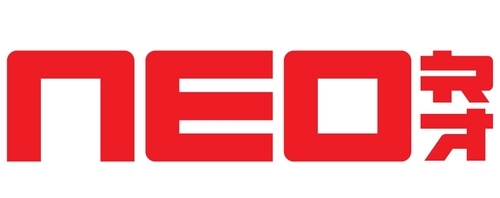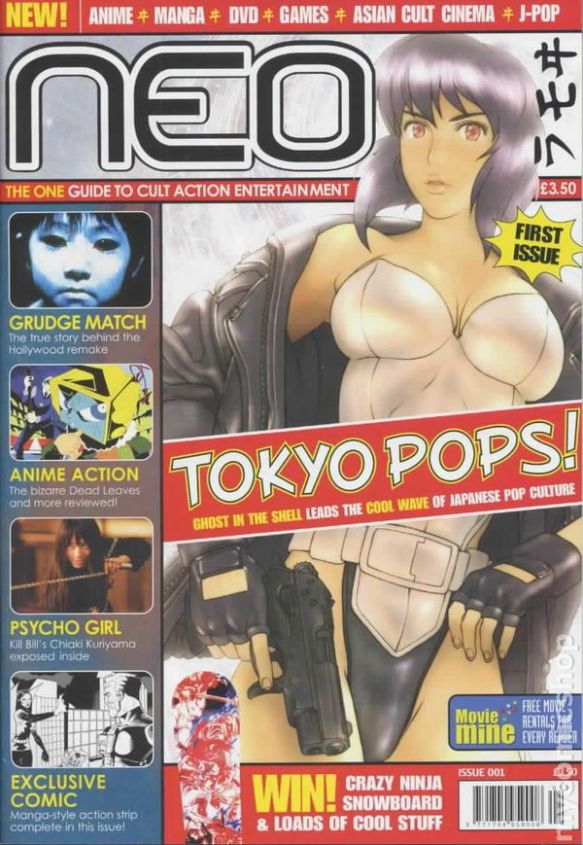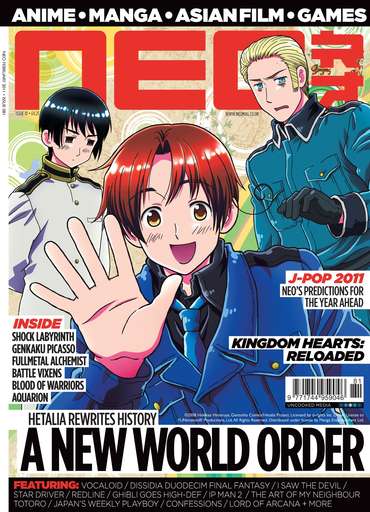14 Years of NEO magazine
April 8, 2018 · 0 comments
By Chris Perkins.
 Here at the Anime Limited Blog we’ve been exploring the history of anime and manga magazines in the UK, with our articles on the history of Anime UK/FX and Manga Mania/Max. But Manga Max published its final issue in 2000, and it’s about time we brought the story up to date, as NEO magazine enters its teens.After 2000, UK anime fans endured a number of wilderness years without a dedicated magazine to call their own. Some dedicated fans imported US titles likes Newtype USA, Anime Insider or Animerica, but this was an expensive option. Importing from Japan was even more costly-and unless you spoke Japanese, it came with a language barrier, too. Some UK publishers attempted to plug the gap with some coverage in Sci-fi, movie or games titles. Future Publishing even produced a number of standalone editions of the SFX spin-off, the Ultimate Guide to Anime, featuring contributions from some of the top names in UK anime criticism. Titan briefly flirted with bringing back Manga Max via a one-off insert in Dreamwatch magazine.
Here at the Anime Limited Blog we’ve been exploring the history of anime and manga magazines in the UK, with our articles on the history of Anime UK/FX and Manga Mania/Max. But Manga Max published its final issue in 2000, and it’s about time we brought the story up to date, as NEO magazine enters its teens.After 2000, UK anime fans endured a number of wilderness years without a dedicated magazine to call their own. Some dedicated fans imported US titles likes Newtype USA, Anime Insider or Animerica, but this was an expensive option. Importing from Japan was even more costly-and unless you spoke Japanese, it came with a language barrier, too. Some UK publishers attempted to plug the gap with some coverage in Sci-fi, movie or games titles. Future Publishing even produced a number of standalone editions of the SFX spin-off, the Ultimate Guide to Anime, featuring contributions from some of the top names in UK anime criticism. Titan briefly flirted with bringing back Manga Max via a one-off insert in Dreamwatch magazine.
 It wasn’t until 2004 that someone would have another crack at launching another monthly anime and manga title in the UK market. In December of that year, the first issue of Uncooked Media’s NEO magazine hit news-stands nationwide.
It wasn’t until 2004 that someone would have another crack at launching another monthly anime and manga title in the UK market. In December of that year, the first issue of Uncooked Media’s NEO magazine hit news-stands nationwide.
The founding editor was Stu Taylor. “At the time,” he recalls, “I was slowly losing the will to live in the admin department of an insurance company in Bournemouth, having been made redundant two times in a row by consumer magazine publishers. At that point, I’d decided to take the safe option of a normal nine-to-five, but continued to write video game reviews for publications like Toxic and comic scripts for Games Workshop’s Warhammer Monthly on a freelance basis.” But Taylor’s days in insurance were numbered, and everything changed when he was contacted by a former colleague, now at Uncooked Media. “We’d previously worked together at one of the publishing houses that had gone tits-up, and he had sounded out a mutual friend to find out whether I would be interested in helping put together an Asian pop culture magazine. The mutual friend was Claire Trent, who was the magazine designer who helped bring NEO to life.”
In the time between then and the first issue hitting the shops, Taylor, Trent and others got hard at work on establishing on what NEO would become. One thing that took a while to settle on, however, was the title. For some time the working title was “Sushi-Ya”, “I honestly can’t remember what we were thinking exactly, but the branding for Yo-Sushi probably played a part,” says Taylor.
 Even before the first issue arrived, another person who would become crucial to the magazine’s history came onboard. “I was at university, and working on MVM’s in-house magazine and freelancing,” remembers Gemma Cox. “I saw the news that NEO was going to be published, so I got in touch with Stu Taylor to ask if I could write for the magazine. I started on issue two, but I was working on NEO before the first issue was published. I asked if there were any jobs going, and then before I knew it, I landed deputy editor, and when Stu left, I took over as editor.”
Even before the first issue arrived, another person who would become crucial to the magazine’s history came onboard. “I was at university, and working on MVM’s in-house magazine and freelancing,” remembers Gemma Cox. “I saw the news that NEO was going to be published, so I got in touch with Stu Taylor to ask if I could write for the magazine. I started on issue two, but I was working on NEO before the first issue was published. I asked if there were any jobs going, and then before I knew it, I landed deputy editor, and when Stu left, I took over as editor.”
Cox was a fan of anime and manga long before she was paid to write about it, so was a natural fit. “I’d been fascinated by anime and manga for a long time before I started on NEO. I remember purchasing VHS copies of Oh! My Goddess (individual episodes for about £20 each!) from Forbidden Planet and lurking in the manga section, browsing through the imported manga mags with no idea what any of it meant, but loving it anyway!”
The magazine’s format featured a familiar mix of anime and manga content, games and other Asian pop culture. The first issue had a non-manga comics insert (actually written by Taylor) which would be replaced by samples from manga and comics publishers in future issues.
 Earlier UK anime magazines were not so much as an influence as you might assume. Instead, they looked to (original Japanese) Newtype (the most iconic of Japanese anime titles) as well as the US published adult-skewed manga anthology Pulp, which featured articles on Japanese movies and music in amongst its comics pages.
Earlier UK anime magazines were not so much as an influence as you might assume. Instead, they looked to (original Japanese) Newtype (the most iconic of Japanese anime titles) as well as the US published adult-skewed manga anthology Pulp, which featured articles on Japanese movies and music in amongst its comics pages.
“Obviously all magazines take some inspiration from the work done before,” says Cox, “but we were just as much influenced by DVD and games review magazines as other anime and manga magazines. It’s always better to forge your own path than to copy what’s come before! We mixed it all up, and that formula has been a winning one for us since.”
Whereas earlier magazines put the emphasis on the anime and manga content, with other coverage more of an afterthought, NEO tried to provide a slightly more balanced diet from the offset. “We wanted a fairly even split of content each issue between manga, anime, music, video games and whatever else we felt represented Asian pop culture.” says Taylor. “It was never an exact science and I know that the balance of the mix changed over the course of the 18 months or so that I was editor.”
“Our coverage of everything from food to games represents a broader interest in Asian pop culture.” Cox adds. “NEO readers enjoy a wide range of interests, activities and hobbies, so although it’s challenging to make sure the mix is balanced, I really think it’s been an important part of the success of the magazine.”
By the time NEO launched, a whole new generation of anime fans had been brought on board by the success of series such as Pokémon. However, by 2004, many fans were also used to getting all their anime and manga news online. Was it too late? Had print magazines had their day? The fact that the magazine is still around after well over a decade would suggest otherwise.
 Gemma Cox puts this down to a number of factors. “There’s something about physical pages that gives a weight to words. Us anime and manga fans have a habit of collecting things as well – I have stacks of old Newtypes hanging around, which I can’t bring myself to throw away despite the fact I haven’t looked at them in years…”
Gemma Cox puts this down to a number of factors. “There’s something about physical pages that gives a weight to words. Us anime and manga fans have a habit of collecting things as well – I have stacks of old Newtypes hanging around, which I can’t bring myself to throw away despite the fact I haven’t looked at them in years…”
“As a diehard magazine fan in general, I just think there’s something magical about opening a big, glossy, gorgeously designed mag every month. Also, the art is a massive part of the appeal of anime and manga – there’s nothing like holding that work in your hands and appreciating it in person rather than on a screen.”
There have been many changes in the industry since the magazine launched, but perhaps the most significant is in the way that fans consume anime itself. The rise of streaming and the simulcast era has seen a move away from physical media for many. NEO has done its best to adapt to the ever evolving market. “We’re always looking for new ways to represent the diversity not just of the media we consider relevant, but how it’s consumed, as well.” Cox says. “Of course, we’re a British magazine and so we’re always going to have reviews of physical releases from the UK.”
The magazine itself has adapted to changes in the print industry too, launching a digital version which can be read on tablets, phones and E-readers. The magazine has an online presence too, with twitter and Facebook alongside the Official Website, but the focus remains the magazine itself.
When NEO first launched, few would have expected it to last as long as it has. Despite challenging conditions in both the print and anime industries, NEO has lasted longer than Anime UK/FX and Manga Mania/Manga Max combined. What’s the secret?
Taylor’s take: “It fills a niche and retains a spirit that appeals to fans and newbies. I do remember that we were written off quite early on by some, but pretty sure that it must be the longest published magazine of its kind”.
Gemma Cox, meanwhile, puts the magazine’s longevity down to “a great team, and great support in the industry too. Plus, our editorial mix, fantastic design by Claire Trent, and continued support from the staff behind the scenes at Uncooked Media. It’s a group effort from hundreds of contributors, from our writers to our advertisers and supporters – but of course, all it’s down to our readers, at the end of the day!”
NEO has always shown a willingness to include those readers in the magazine’s pages too. Beyond the usual letters pages and fan-art sections, it features a range of reader-generated content including reader reviews, art showcases and the annual NEO awards. This interactivity may well also be an important factor in the magazine’s continuing success, despite increased competition.
Of course, keeping a magazine going for so long is not without its challenges. “The biggest challenge is deciding what to exclude every month,” says Cox.” “There’s so much to cover that it’s very tough, especially if you have to say no to something you’re personally interested in! Approval processes can sometimes be stressful, particularly if you’re dealing with more than one time zone and you’re down to the wire!
But it’s full of pleasures too: In particular, Cox loves “the fact I get to work on a publication like NEO, sharing Asian pop culture with other fans – it’s a genuine privilege and I consider myself incredibly lucky.
Fourteen years on, NEO continues to flourish. But what does the future hold? “What else can you hope for except for more of the same?” asks Gemma Cox. “Here’s to many more years of sharing Asian pop culture with our readers, both in the UK and further afield! I’d love to share more about our plans, but we have a lot of new projects going on at the moment behind the scenes here – let’s just say that 2018 will be NEO’s best year yet!
Chris Perkins is the editor of Animation For Adults.
Leave a Reply